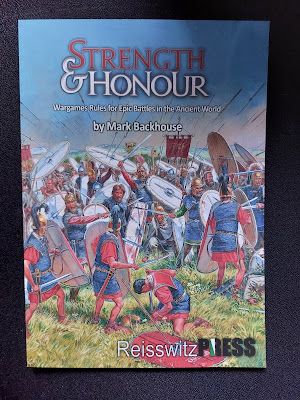I finally managed a proper game of Blood Red Skies this week. Checking back on the blog I discovered that I bought the starter set 4 years ago but they've never seen action!
I'd played one game of this at the Guildford club back in 2018... it was a large multiplayer version which didn't use all the rules if I remember correctly. I was impressed though and promptly picked up a copy of the starter set. I'd painted up the planes that come with this but never completed them. The original starter box came with some rather naff stickers for roundels and crosses rather than proper decals and I never got round to acquiring the proper ones until recently.
I spent the weekend swearing loudly at the set of Spitfire and Me109 decals that I'd bought but managed to get them mostly applied safely (as long as you don't look too close... there are 6 planes and 7 sets of decals so you only get 1 chance to mess up!). I'm pleased when the results though...
Incidentally when I discovered that the Warlord Games decals are for 602 City of Glasgow Squadron I was sold... I hadn't realised that they still exist (now as a RAAF squadron) and are based about a mile or so from my old home in Glasgow.
The game avoids the complications that often come with air games... altitude bands, complicated manouvers etc... by using stands which can be angled backwards as though the plane is climbing (to show 'advantage') or angled downwards (to show 'disadvantage'). This neatly simplifies all the height issues and advantage can be used to increase speed or manouvreability.
Hits from firing are quite hard to achieve and it's even harder to actually cause damage. A successful hit forces a plane to a lower advantage status and a disadvantaged plane which is hit is then shot down. More importantly a successful hit, even if it causes no damage, inflicts a 'boom chit' on the victim (terrible terminology!). Once you have more 'boom chits' than planes the squadron turns tail and flees, which feels right... driving off enemy planes was a more accurate result than everyone being shot down.
Each side also has a selection of cards based on the type of plane, the period of the war and the theatre which add some extra depth.
Our game pitted 4 Spitfires against 4 Me109s in a straightforward encounter scenario. The game rewards spending some time manoeuvring and positioning to get onto the tail of your opponent and the tight turn of the Spitfire proved really effective at this. It also pays to have a wingman who can soften up an opponent and force them to a disadvantaged state before their partner moves in for the kill.
I was really pleased with how they played and will definitely use them again... it's fair to say my opponent was less impressed (despite winning) and found the mechanics harder to get to grips with but I guess that's the nature of wargames... we all have different tastes.




















